| .......... ALEXMOD: projects |
|
Секреты самураев-аудиофилов: Yamaha YH-100 (orthodynamic)
| |
| Alex | Дата: Пятница, 16.06.2017 | Сообщение # 1 |
 Автор сайта
Группа: Администраторы
Сообщений: 3035
Репутация: 120
Статус: Offline
| В конце 70х годов прошлого века Hi-Fi отрасль в Японии испытывала небывалый расцвет. Касалась эта тема и наушников. Компания Yamaha аккурат в год моего рождения презентовала первые модели наушников с излучателями ортодинамического типа, радикально иного принципа чем электродинамические, с подвижной катушкой.

Первыми исторически (1975) была модель HP-1, очень родная взгляду российских аудиолюбителей прошлого века, поскольку именна эта модель была клонирована нашими производителями и продавалась в CCCР как ТДС-5.
Цитата Если кратко про наиболее известные модельные линейки ортодинамики Yamaha, то их 3:
1. Yamaha YH-1000. Других моделей в линейке нет.
Полуоткрытые, алюминиевые чаши, магниты из редкоземельных металлов,
медный проводник на мембране, заводское полноценное демпфирование.
Уникальное оголовье.
2. Yamaha YH-100. Других моделей в линейке нет.
Закрытые наушники с вентиляционными отверстиями. В оригинальном виде имеют сильный акцент на басе, бас глубокий.
3. Yamaha HP/YH-1,2,3. Линейка состоит из 3-х моделей. HP - более ранние варианты, видимо, делались поначалу только для внутреннего
потребления в Японии. YH - более поздние варианты, продавались дешевле, с худшим контролем качества.
HP(YH)-1 - старшая модель в линейке. Не хватает нижнего баса, который есть у YH-100, в остальном звучание аналогичное 100-й модели. В России заочно самая известная модель, так как именно с нее
"содрали" конструкцию при "разработке" Электроники ТДС-5.
HP(YH)-2 - изготовлена из более дешевых материалов по сравнению с HP(YH)-1, в частности, что приводит к крошащимся со временем амбюшурам. Контроль качества у YH-2 хуже, что приводит к большему разбросу в звучании между экземплярами, чем в случае HP-2.
HP(YH)-3 - отличается оголовье, менее хрупкое, лучше подходящее к портативному использованию. Еще хуже контроль качества.
Некоторые экземпляры - монстры баса, другие - с весьма хлипким басом. В
итоге можно купить экземпляр, напоминающий "YH-100 для бедняков", или гораздо менее удачный экземпляр с проблемным басом. Для YH-3 была еще вариация с маркировкой HP-50, которая продавалась в комплекте с синтезаторами yamaha.
Хронология:
1975 - Yamaha HP-1, HP-2.
1976-? Yamaha HP-3.
1978 - Yamaha YH-1000, HP-1000, YH-1, YH-2 , YH-3.
1979 - Yamaha YH-100.
Драйвера:
Yamaha YH-1000. Драйвер 50 мм, магниты из редко встречающихся в природе церия и кобальта.
Yamaha YH-100. Драйвер 55 мм. Использованы более сильные железные магниты, поэтому чувствительность на 4дб лучше, чем у HP(YH)-1, при равном размере драйвера.
HP(YH)-1. Драйвер 55 мм.
HP(YH)-2. Драйвер 46 мм.
HP(YH)-3. Драйвер 46 мм.
Легким особняком была модель вставных ортодинамических наушников Yamaha YH-5m на базе уникального излучателя , материал о которой есть здесь на сайте. Чуть позже появилась линейка YHD для потративного применения, на базе более маленьких драйверов и со складным оголовьем.
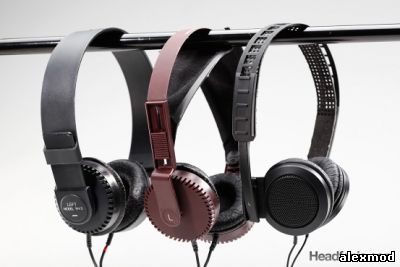
Yamaha YH3, YH2 и YHD-2
Самые дорогие модели из всего этого винтажного наследия (и самые редкие) это HP(YH)-1000 и YH-5m на базе сложных магнитных систем, отличающиеся очень высокой индукцией в зазоре и чувствительностью, в итоге.
Чуть ниже в табели о рангах идет топовая модель линейки 1980-81 года YH100, о которой далее и пойдет речь...
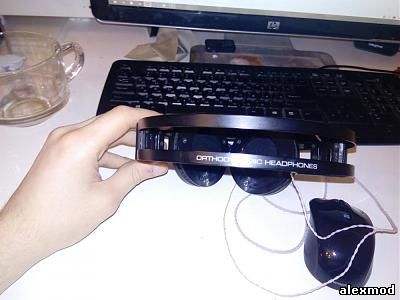
Оголовье представляет собой нечто среднее между HP(YH)-1 и HP(YH)-1000


Драйвер 55 мм, по диаметру эквивалентен таковому у HP1, но громче на 4дб.
Love the MUSIC, not equipment!
High-end portable now has a simple solution: aleXmod+RE272
|
| |
| |
| Alex | Дата: Пятница, 16.06.2017 | Сообщение # 2 |
 Автор сайта
Группа: Администраторы
Сообщений: 3035
Репутация: 120
Статус: Offline
| Замер от innerfidelity
И для савнения на тех же стендах
Yamaha HP-1
Yamaha YH-3
Love the MUSIC, not equipment!
High-end portable now has a simple solution: aleXmod+RE272
|
| |
| |
| Alex | Дата: Вторник, 20.06.2017 | Сообщение # 3 |
 Автор сайта
Группа: Администраторы
Сообщений: 3035
Репутация: 120
Статус: Offline
| Оставлю тут обьемную табель о рангах сред винтажной ортодинамики (как всегда, относится к рейтингам стоит с попроавкой на субьективизм, но тем не менее):
Цитата Wualta: 05-15-2009
My opinions are based on the mods we have as of this moment and ranked by the results of those mods that I have heard
myself, with exceptions noted. Tomorrow someone will get a bright idea
and cure a longstanding peeve. A miracle might even occur: Someday,
someone might be able to get bass from a Bang & Olufsen U70 without
EQ. So this ranking is fluid. Case in point: the recent discovery by the
proprietor of this here Wiki that Fostex significantly improved the
sound of the once-thought-worthless current production T50RP. So don't
just read the top few entries and run off waving your mom's credit card
at the nearest online auction.
Some mods are effective but getting them just right is a pain. Some headphones are just physically
difficult to work on. These are noted but don't affect the ratings.
And it's worth repeating that with different mods come very different
sounds from a single headphone. You can customize many of these 'phones
to match your equipment, and of course different equipment will change
the sound a headphone makes. It should be kept in mind that lesser
phones, once modded, can have more treble and bass extension than even
the vaunted T50v1, but won't have its openness and the ease of a certain
big-diaphragm je ne sais quois. So hang loose, ortho brothers; none of
this is chiseled in stone.
Top Tier:
1. Fostex T50 (original version, 1978-79, aka T50v1)-- Really stinkin' rare. Keep your
eyes peeled but don't hold your breath. Sounds very much like the Stax
SR-X Mk 3 but with bass. Not basshead bass, and not the best, tightest
bass you ever heard (the little Pro 30 beats it) but clean, pleasing
bass. One of the hallmarks of the sound of this phone is emotional, not
acoustic: when you wear the T50 you get the feeling of being in a world
where everything is wonderfully balanced, where nothing is too much or
too little, like good Asian cuisine. The T50 does everything well,
though it does nothing better than all others. The response is smooth,
extended (but not too much) and flat. Damping is factory-tuned (but
because there is damping, headstage is not Lambdalike as you might
expect). It's reasonably efficient (for good dynamic range) but not so
much that you'll hear residual amp noise.
However, with all the different levels of Hell you'll have to go through to get one, the
psychic bottom line looks far better for one of the 2nd tier 'phones,
which can be modded to give similar, sometimes superior, but not
identical results. Did I say rare? Rare. Fostex never made another
headphone like it, and neither did anyone else. Is it the Best Headphone
Ever? No, not at all, just a very capable and enjoyable one for the
reasons outlined, and a great preview (or tease) of the isodynamic
future that never came but which may yet come. Don't step on a friend to
obtain one-- it's not worth that.
2. The T50 (2 versions, 1978-79 and 1980-?) is not to be confused with the different-looking 2002 Fostex T50RP (which also has two versions. See below). The 1980 Fostex T50v2,
which looks like the v1 but with a different headband and subtly
different cosmetics, is related to the v1 but uses a visibly different
diaphragm. Only 1 example is owned by an HF member, and I haven't heard
it. Confusingly, Fostex called it simply a T50.
Also confusingly, Fostex OEM'd several versions of the T50v2 using drivers that looked
like (but didn't sound like) the T50v1's for NAD, Maior, Lafayette, and
possibly others, but using the headband and cosmetics of the T50v2. None
of these "clones" can be ranked as high as the T50v1, usually because
the treble is weak, but not always (the uber-rare Maior is an
exception).
Even more confusingly, there's evidence that some of the clones and variants actually predate the North American market
introduction of the T50, leading to the suspicion that what the NA
market knows as the T50 was actually a special model designed
specifically to emulate the sound of electrostatics of the day. The Stax
SR-X Mk 3 was introduced about a year earlier. Coincidence?
Close to top but with reservations:
3. Yamaha YH-100-- This is a vented-closed 'phone, so it'll never sound exactly like a T50, but it can sound really freakin' good in a variety of ways.
Has bass and treble extension beyond that of the T50. Tricky to get
exactly precisely obsessively perfectly right, but one of the few old
Orthos that needs make no apologies.
[Полузакрытый дизайн означает что эта модель никогда не будет звучать также, как Т50, однако YH-100 звучат чертовски привлекательно и своеобразно. И бас и ВЧ более протяжены чем у Т50. Чтобы быть предельно точным, это одна из моделей старой ортодинамики беспощадно правильная по звуку]
4. Yamaha YH-1000-- Yamaha's flagship TOTL SOTA Orthodynamic. Even more rare than the Fostex
T50v1, but you'll hear a lot about it, so it's here. Yamaha put the big
earcup attachment/adjustment block right behind a vented-back earcup (a
no-no), but yes, the YH-1000 does have a semi-open back and Yamaha did
use some mechanical damping (plus some acoustic absorption) in the 1000,
the only time they ever did both on any Orthodynamic. A quick look at
the service manual and it's obvious Yamaha was pulling out all the Ortho
stops (semi-open back! aluminum cups! rare earth magnets! copper voice
coil! damping!). Nevertheless, it's basically a first-generation
Orthodynamic, with a nontensioned pleated diaphragm clamped in the
center, just like the HP-1/2/3.
Few people own this phone and fewer have described its sound, but the ones who own it do like it a
lot. Sonically, it's dark, obviously a relative of the YH-100, but like
the YH-100 it has great potential. The one example I've heard has light
damping added but is still dark, pretty much as the frequency response
graph published by Yamaha shows-- a 3dB/octave downward tilt hinged at 1
kHz. This is usual for Orthodynamics, but the YH-1000 seems more linear
(fewer bumps and detours in the tilted response curve) than its lesser
brothers, which means the diaphragm is well-controlled and the response
should flatten out nicely with relatively simple modifications. The
linearity means that this headphone will sound pleasing even when its
response hasn't been made flat.
Caveats: Two known examples have had corrosion problems on the copper voice coil, requiring painstaking
repair involving disassembly of the driver and the use of a binocular
microscope to re-paint the tiny copper traces. Something to keep in mind
if one is contemplating spending big money for a YH-1000. Also, despite
the metal earcups, the struts that attach the earcups to the headband
are plastic, as in the HP-1/2/3 and YH-100. Don't drop this 'phone.
A rare landmark headphone in great demand.
5. Fostex T20RP (first version, aka T20v2-- another good all-rounder, not rare, usually reasonably priced, and easy to work on. Dull and blah in stock
form, though not actively unlistenably bad. Like the YH-100, needs
extra-dense damping materials, which may take some time to find. Not to
be confused with the later and similar-looking T20RP mk II, which is
good only if it has the new-style earpads.
6. Yamaha YHE-50S-- another very rare one but since it's based on the more common YHD-3
(which I haven't heard, but which should be very similar), and has
unique features which can be copied by DIYers, I thought I'd include it.
Think of a miniaturized YH-100 with an open(ish) back. That's saying a
lot. There's also a mono version, the YHE-50A. Small enough and
efficient enough to be used with portable gear. Rated over the TOTL
YHD-1 and YHD-2 because it has earcups (backwave control) and earpads
(ditto). Note that the YHD-3 lacks the earpads and uses fabric-covered
foam slabs instead.
Love the MUSIC, not equipment!
High-end portable now has a simple solution: aleXmod+RE272
|
| |
| |
| Alex | Дата: Вторник, 20.06.2017 | Сообщение # 4 |
 Автор сайта
Группа: Администраторы
Сообщений: 3035
Репутация: 120
Статус: Offline
| Цитата 2nd tier:
Yamaha HP/YH-1-- A good place to start your career as an apprentice Orthodynamicist. The low
bass of the YH-100 is missing, but everything else is there with the
simplest of mods (the socalled Stage One-- a simple felt disc or two
placed behind the driver). If you're not a basshead, get one while the
online auction prices are still reasonable... sometimes. Not the easiest
headphone to work on due to idiosyncratic mechanical design. NOTE:
There's an upgraded HP-1 with "keeper" plates on its magnets, giving 2dB
greater efficiency. Comes in a black (not silver) box, still labeled
"HP-1". Look for the phrase anisotropic ferrite in the specs.
Yamaha HP/YH-2-- Used some cheaper materials than its big brother the HP/YH-1,
leading to some problems with crumbling foam in some cases, but
sonically very like the HP/YH-1. Just won't play as loud. Comes in a
spiffy maroon color. Quality control is a bit looser on this pair of
twins, so your YH-2 may not sound like your HP-2. A pain to work on,
though as with the HP/YH-1, the results will wash away your tears.
Yamaha YHD-1 and YHD-2-- I badmouthed the YHD-2 for years, but mine must have
been atypical-- a nice way of saying busted. Oh,the hazards of judging a
headphone from a single sample! Auditioning another YHD-2 plus the
evaluations of other YHD-2 owners over the years has shown that the
YHD-2 is a slightly less efficient and bassy YHD-1, pretty much as we'd
expect. Smooth but dull out of the box, but that's what we want for a
good modification outcome. A work of art that's actually a good working
headphone. Downgraded only because they lack pads (which can be tweaked
to tweak the sound) and cups, which give you backwave control plus room
for damping materials. Otherwise they'd be in the 1st tier with the
YHD-50S. As compensation the open design offers some extra headstage.
Audio-Technica ATH-2 -- Not too common and slightly crippled by a thick,
stingily-perforated baffle, it's one of the very few inexpensive
isodynamics with an open back. Easy to work on. Driver virtually
identical to the one in the Pro 30. To operate at its full potential,
the baffle has to be partially cut away, so not an easy mod for
perfectionists.
Realistic Pro 30-- Cheap to buy, easy to mod, can give astounding results for effort expended, good (I'm tempted to say
killer) bass, compact on the head except for the "antlers". What's not
to like? Well, maybe the slightly elevated (but flat) upper midrange and
treble. Sentimental favorite, since it was my first wholly successful
mod, ca. 1987. The 'phone that should've spread isodynamicry to the
masses, and may yet.
Yama HP-3/YH-3-- A bit of a gamble, due to very loose quality control. Some HP/YH-3s are poor-man's YH-100s and
some aren't. Not the most common of the Orthodynamics, but not rare
(yet). The variant HP-50 series(50, 50A, 50S) were designed to be sold
with Yamaha electronic organs. Some claim the HP-50 series uses a
unique, superior driver-- all I can say is mine does sound more like my
YH-2 more than my HP-3 or YH-3. HP-50 series 'phones all come with a
white paperlike layer over the front of the driver-- intended function
yet to be determined. Snap-together construction (no screws), which
sometimes leaves backwave-leaking gaps. NOTE: The HP-50A is wired mono
and must be recabled for stereo.
Fostex T40RP (first version, aka T40v1-- The lack of deep bass is a deficit but not a huge one and bass
EQ works well. Very extended and smooth top end, like no other non-stat
headphone I've heard. One of the easiest mods (a chunk of foam) gets you
there. Same warning as above about confusing this with its Mk II
version applies.
3rd tier:
Fostex T50v2 OEMs, aka "T50v2 clones" or "T50 clones" (1980--86?)-- (includes NAD RP18, Maior
RPT-50 and Lafayette RP 50)-- For the 1980 model year, Fostex changed
the T50's headband from pivoted twin leather-covered-steel bands to a
single padded plastic piece, and this is the headband we see on the OEMs
labeled Maior, NAD, and Lafayette. Frankly, and to give you a basis for
comparison, I like the modded YH-100 far better than the Maior, which
suffers because it has an elevated midrange / treble. The NAD, on the
other hand, starts dropping after ~2 kHz and keeps dropping-- Bass City.
Now, having said that, the clones are T50s in every other respect-- it
just sounds like there's a little guy inside with a graphic equalizer
who's hellbent on futzing with the sound. Sigh. UPDATE: as noted above,
these have what look like T50v1 drivers inside a chassis that looks like
the T50v2, but the genuine and exceedingly rare Fostex-branded T50v2
(which Fostex flabbergastingly insisted on labeling simply T50) has a
similar driver with a unique diaphragm and which doesn't sound like any
of the OEM clones, according to the one owner we know of. Confused yet?
Again, this not to be confused with the much later and very different T50RP,
which, I remind you once more, is now being smiled upon by Fostex in the
form of life-giving new earpads, making it, in today's online-auction
market, 1) affordable 2) available 3)listenable (good, not great) in
stock form. Which is so unexpected it's ridiculous. So: if it doesn't
have the new earpads (see the T50RP section of this wiki for photos),
don't buy it. Make sure your seller has the latest production, known in
Japan as T50RPn.
Fostex T30-- Great potential, but will need a lot of work to get at all of it. Very similar to the T50 inside, but
with a less powerful, slightly less open magnet structure and a sound
that's tilted basswise very much like the NAD, above. Though the dark
sound of the big diaphragm grabs your attention right away and you find
yourself listening to it, you won't for long-- the T30 is shockingly
uncomfortable to wear. Just about as rare as the T50. Some HFers have
devised big circumaural pads for the T30 that make it comfortable.
Sansui SS-100-- Fostex-made, with a driver that's a cross between the one in
the T50v1 and the T30 but slightly closer to the T50. Arguably the
prettiest ortho/iso ever made. Sonically similar to the Maior RPT-50
(good, not great; weak bass; not easy to work on), ergonomically clumsy
(the earcups don't pivot but float on a rubber subchassis) and therefore
a disappointment. Rare again.
Fostex T20v1-- Fostex's most famous headphone, used in recording studios worldwide, but definitely
not audiophile material without modding, and difficult to get sounding
just right. Comfortable, not expensive, easy to work on, but not very
efficient and has an upper midrange peak that's hard to tame because
it's caused by the conical shape of the baffle.
Love the MUSIC, not equipment!
High-end portable now has a simple solution: aleXmod+RE272
|
| |
| |
| Alex | Дата: Вторник, 20.06.2017 | Сообщение # 5 |
 Автор сайта
Группа: Администраторы
Сообщений: 3035
Репутация: 120
Статус: Offline
| Цитата
4th tier:
Interesting 'phones but ones that respond very little to simple modification--
that's why they're here. Most use the 55mm driver made by Peerless
Mikrofon Bau, PMB, now known as MB Quart. I keep hoping someone will
find the killer mod for these. I've been waiting four years.
Peerless PMB 100-- Best of this group. Two versions: Early version used a
unique, damped PMB 55mm driver with extra, chamfered holes in a
felt-filled chassis, and only HF member JadeEast owns one. Later
version, which used a standard PMB 55mm driver in a hollow box chassis
with absolutely no acoustic treatment, sounds wonderfully flat, though
dry, from about 100 to 150 Hz on up. Below 150 Hz there be hippogryffes
but not much bass, which will be found to have fallen off the edge of
the map and lost in the shag. Strange Jecklin-design headset that
promises much but delivers only a little. Some violently disagree with
this, but I don't hear the spatial enhancements promised by the Jecklin
open-frame architecture. And to me, the sacrifice of that much bass
isn't worth it.
Telefunken TH 700-- Made by PMB in Germany using PMB's big 55mm pinch-type driver. Not much bass or treble.. and it's
factory damped! Maybe with a LOTTA work...
B&O U70-- I'm a big industrial design freak, but enough is enough. A work of art first
and always, and only secondarily a working headphone. The U70's driver
doesn't improve significantly in a more sympathetic chassis. Uses the
visually-same PMB driver as the TH 700. Top octave sliced off. Not much
bass. It's at least easy to work on since its aluminum-clad plastic body
snaps together.
RFT HOK80-2-- Made in East Germany, the old DDR. This phone and the next both use what appears to be the same 44mm
East-German-made driver, believe it or not. The HOK has not much bass
(very reminiscent of the PMB 100) and is very inefficient but decent
mids and top end. Horrible earpads with a lifetime of about 2 years max,
but still serviceable even after the seams have split. A very brave
attempt considering the political and economic conditions of its birth.
Historically significant and shows rare sensitivity to the driver type.
Easily convertible to open-back, as if this were a feature planned by
the designers. Will accept incredible amount of bass boost and will
deliver real bass if you have the amp and EQ for it. Snap-together
construction using sometimes brittle materials let some bass backwave
leakage occur. Difficult to work on and not for everybody, but hard to
ignore. Bass can be improved with dense, low-profile DIY earpads as
demonstrated by a dedicated HF member, DefectiveAudioComponent, also
known as DAC.
Goodmans OHP-10-- Very nice PMB-made (West German) headset with the East German drivers inside. The sound? well.. with
flatter earpads and some better baffle seals... As it is, it doesn't
sound as flat as the gnarly little HOK80-2! I seem to have the only pair
on HF, and that's just as well.
5th tier:
Technics EAH-830-- Very innovative technically but with weak magnets and an
uncomfortable, unnecessarily heavy headset and disappointingly blah
sound.
RFT HOK80(v1)-- The first version of the HOK80. Interesting, but NO bass and very inefficient. What's there is
surprisingly good, but...
Wildcards: I've only heard one of these myself, but they're tantalizing enough to mention them here, and
we have some pretty thorough descriptions and mods going on the Big
Thread.
Wharfedale Isodynamic(the original 1972 model, aka ID-1)-- I've heard a slightly modified (rear of driver sealed to back of
cup) example and except for a big high-Q resonance in the upper bass,
it's amazingly good, especially when you consider it was the first
isodynamic headphone on the world market and sold for £20 (!!). Very
rare in the US, much more common in the UK. Only one HFer owns one in
good nick. Not surprisingly, he loves it. A notch filter would be a
necessary accessory to live with it long term, but with that the
Isodynamic shoots very close to the top. Very inefficient-- works best
from speaker amps. Is it a "good-but"? More like a "great-but".
Wharfedale ID-2 / Leak 3000-- one member of the Euro Wing of orthodom does own
these twins (which don't sound alike), and he better get busy and put
his impressions up here. The drivers look similar to the ones in the
Fostex T30 and T50. Not surprising, since Fostex licensed the technology
from Rank, who bought up Wharfedale, Leak, and Strathearn.
Amfiton TDS-15 and Echo TDS-16 (early version)-- These tantalizing Russian
(Ukraine) 'phones are owned by a couple of Euro HFers. The TDS-15 is
approximately a Russian Fostex T50, with bar magnets and a serpentine
voice coil but with unique features seen nowhere else. The TDS-16 is
more like a YH-1 inside (perforated disc magnets, spiral voice coil) but
the driver has clamps like a PMB and a flat, non-pleated diaphragm, not
like a PMB. See the Big Thread for the owners' impressions.
Grundig GDHS-223 and 224-- One is a Fostex OEM with a T20v1 driver inside, the
other uses an odd driver that we've seen nowhere else but looks a bit
like the one in the PMB 100 v1, but with no clamps. One owner of the
224, one owner of the 223. Impressions and ongoing mods on the Big
Thread.
Dual DK-720-- Again, one Euro owner, mods ongoing, looks promising. Has some
features of the HOK 80 (!) but uses a low-tuned 55mm
PMB driver.
Love the MUSIC, not equipment!
High-end portable now has a simple solution: aleXmod+RE272
|
| |
| |
| Alex | Дата: Среда, 21.06.2017 | Сообщение # 6 |
 Автор сайта
Группа: Администраторы
Сообщений: 3035
Репутация: 120
Статус: Offline
| Рецепт демпфирования YH100 от Tomek (head-fi):

Драйвер приклеивается к передней чашке. На торец драйвера и по периметру чашки наносится самоклеящийся битумный материал типа Вибропласта M2

По диаметру дрйвера (55мм) вырезается кольцо и наклеивается на драйвер сзади.

Вокруг драйвера (на переднюю крышку) наносится два слоя М2

Чтобы задняя чашка наушников была более ровной наклеиваем кольцо М2 и сзади.

Основной демпфирующий слой делается из ватного диска, в центр которого вставлен диск из стеклоткани.
Love the MUSIC, not equipment!
High-end portable now has a simple solution: aleXmod+RE272
|
| |
| |
| Alex | Дата: Среда, 21.06.2017 | Сообщение # 7 |
 Автор сайта
Группа: Администраторы
Сообщений: 3035
Репутация: 120
Статус: Offline
| 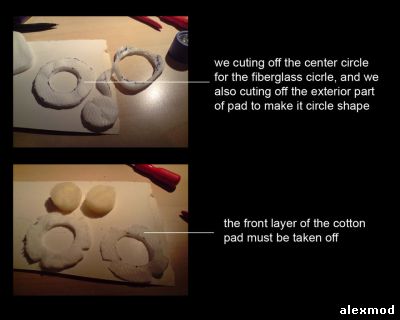
Обрезаем ватные диски под имеющиеся крепежные выступы на задних чашках.
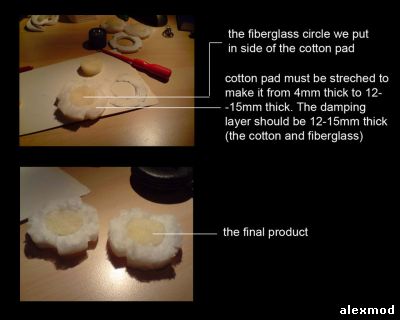
Распушаем конструкцию демпфера.
При исходной толщине ваты в 4мм, у нас должно получиться 12-15 мм.

После помещения демпферов на место внутрь чашки убеждаемся что они не сплющились, это важно! Толщина должна составить 12-15мм.
Love the MUSIC, not equipment!
High-end portable now has a simple solution: aleXmod+RE272
|
| |
| |
| Alex | Дата: Среда, 21.06.2017 | Сообщение # 8 |
 Автор сайта
Группа: Администраторы
Сообщений: 3035
Репутация: 120
Статус: Offline
| Рецепт демпфирования от ludoo (head-fi):
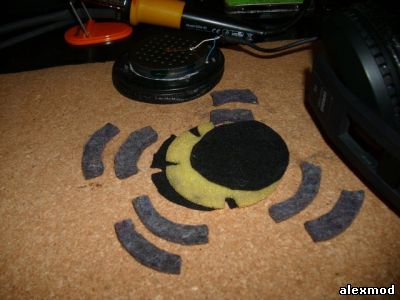
Плотный фетр для демфирования крайних отверстий драйвера (серый цвет)
Стоковый пролон (желтый)
Тонкий плотный фетр (черный цвет) закрывает полностью чашку и еще один (меньшего размера) расположен прямо за драйвером)
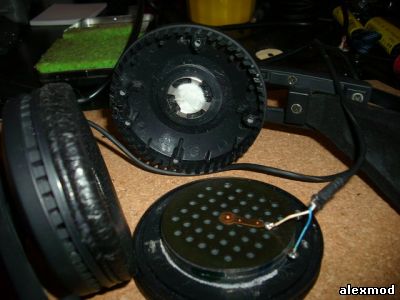
Драйвер приклеен к передней крышке.
В центр чашки в месте крепежа вложен ватный шарик.

Все демпфирующие слои за исключением финального кружка, располагающегося непосредственно за драйвером, уложены в чашку.
Данная схема демпфирования хорошо работает со стоковым кабелем, однако при его замене звук получается слегка ярковат. В этом случчае стоит поэкспериментировать с материалом круга, расположенного сразу за драйвером.
Еще одна версия демпфирования Tomek:
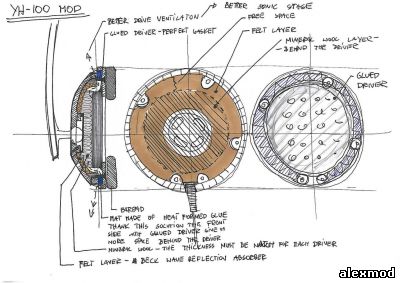
Детальный разбор (скан service manual):

Love the MUSIC, not equipment!
High-end portable now has a simple solution: aleXmod+RE272
|
| |
| |
| Alex | Дата: Среда, 21.06.2017 | Сообщение # 9 |
 Автор сайта
Группа: Администраторы
Сообщений: 3035
Репутация: 120
Статус: Offline
| Ну и до кучи немного замеров с альтернативного источника (Changstar.com)
АЧХ YH-100 (модифицированного в непонятной степени):

MLSSA YH-100:
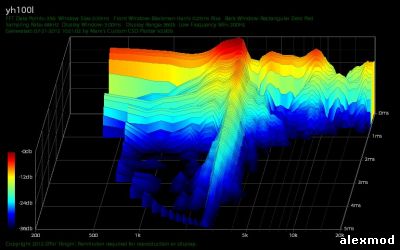
Для сравнения MLSSA YH-1:

Замер Кг показывает что по искажениям YH-100 лучше чем YH-1:
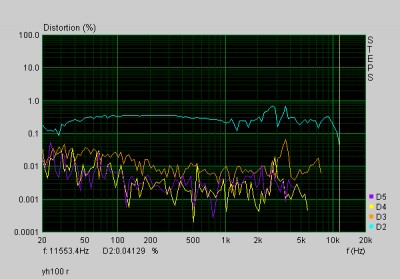
Love the MUSIC, not equipment!
High-end portable now has a simple solution: aleXmod+RE272
|
| |
| |
| Alex | Дата: Понедельник, 21.01.2019 | Сообщение # 10 |
 Автор сайта
Группа: Администраторы
Сообщений: 3035
Репутация: 120
Статус: Offline
| 
Love the MUSIC, not equipment!
High-end portable now has a simple solution: aleXmod+RE272
|
| |
| |
|
|
|